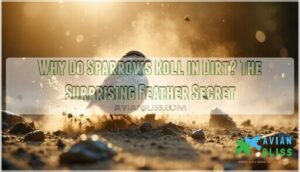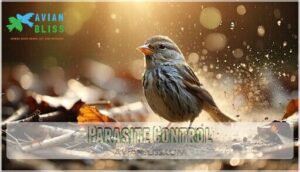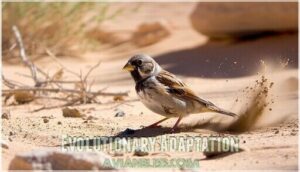This site is supported by our readers. We may earn a commission, at no cost to you, if you purchase through links.
 You’ll notice sparrows creating little dirt craters and fluffing around like they’re throwing a feathery fit—this behavior, called dust bathing, serves multiple purposes.
You’ll notice sparrows creating little dirt craters and fluffing around like they’re throwing a feathery fit—this behavior, called dust bathing, serves multiple purposes.
The fine particles absorb excess oils from their preen glands that would otherwise make feathers greasy and matted. It’s also nature’s pest control system, helping dislodge mites, lice, and other tiny hitchhikers that love bird feathers.
Without regular dust baths, sparrows can’t maintain proper insulation or flight efficiency. They’re surprisingly picky about their bathing spots too, often returning to the same dusty patches daily.
There’s actually more fascinating science behind this seemingly chaotic behavior.
Table Of Contents
- Key Takeaways
- Why Do Sparrows Roll in Dirt?
- Feather Maintenance
- Parasite Control
- Dust Bathing Behavior
- Feather Conditioning
- Feather Renewal
- Social Interaction
- Evolutionary Adaptation
- Frequently Asked Questions (FAQs)
- Do sparrows roll in dirt?
- Why do birds roll in dirt?
- How do house sparrows get dust?
- Do house sparrows like dust baths?
- Why do birds fluff themselves in dust?
- Why do birds take a dirt bath?
- Why do birds spin in the dirt?
- Why do birds rub their body in dirt?
- Why do sparrows make holes in the ground?
- Why do birds roll around in the dirt?
- Conclusion
Key Takeaways
- You’ll see sparrows rolling in dirt because it’s their natural cleaning system—dust particles absorb excess oils from their feathers and smother parasites like mites and lice that would otherwise cause health problems.
- Their dust bathing isn’t random chaos—it’s essential maintenance that keeps their feathers properly conditioned for flight efficiency, insulation, and waterproofing by preventing greasy buildup that would weigh them down.
- You’re watching a social activity when sparrows dust bathe together—these communal sessions strengthen flock bonds, establish dominance hierarchies, and provide learning opportunities for younger birds.
- This behavior proves sparrows have evolved a water-free cleaning method that’s perfectly adapted to dry environments, allowing them to maintain peak health even when water sources aren’t available.
Why Do Sparrows Roll in Dirt?
Ever wonder why you’ll spot sparrows having what looks like a dirt party in your garden?
These clever birds aren’t just playing around—they’re performing essential dust bathing for bird hygiene.
This sparrow behavior tackles feather maintenance by removing excess oils and debris while controlling parasites.
The dust mechanics work like nature’s dry shampoo, supporting feather health and thermoregulation.
It’s their go-to grooming ritual that keeps them flight-ready.
Feather Maintenance
Have you ever watched a sparrow frantically tossing dirt over its back and wondered what’s going on? This dust bathing behavior is actually sophisticated feather maintenance that keeps these small birds in peak condition.
When sparrows work fine particles through their plumage, they’re performing feather cleaning on multiple levels. The abrasive dust absorbs excess oil from preen glands, preventing feathers from becoming greasy and clumped.
Nature’s dry shampoo keeps sparrows flight-ready through dirt’s oil-absorbing magic.
This oil regulation maintains proper feather structure – keeping individual barbs separated and flexible rather than matted together. Think of it like dry shampoo for birds.
The dirt particles bind to accumulated oils and debris, making them easier to shake off during subsequent preening sessions. This process preserves the intricate barbule structure that creates effective insulation maintenance and waterproofing.
Regular bird hygiene through dust baths maintains ideal plumage health, allowing sparrows to maintain their aerodynamic efficiency and thermal regulation. Without this natural cleaning system, their feathers would lose their vital properties.
By understanding the importance of proper feather cleaning tips, we can appreciate the complexity of a sparrow’s grooming routine.
Parasite Control
When you observe sparrows creating dust clouds, they’re waging war against tiny invaders. Parasite removal becomes their primary mission as fine dirt particles work like microscopic warriors, smothering bird parasites and disrupting their life cycles. This dust bath behavior isn’t just grooming—it’s survival.
Nature’s tiniest warriors wage chemical warfare, turning dirt into their secret weapon against invisible enemies.
Here’s how sparrows master parasite control:
- Mite control through suffocating dust particles that clog parasite breathing systems
- Lice elimination via abrasive dirt that physically dislodges clinging pests
- Feather cleaning removes parasite eggs before they hatch
- Skin health improves as irritating pests get scraped away
- Feather parasites lose their grip when buried under protective dust layers
This bird mite control strategy proves remarkably effective, reducing parasite loads by up to 50% in regular dust bathers. Effective bird mite control methods are essential for maintaining healthy bird populations.
Dust Bathing Behavior
Sparrows don’t just randomly roll around in dirt—they’re following a sophisticated dust bathing ritual that’s been perfected over millions of years.
You’ll watch them dig shallow hollows with their feet, then push their bellies deep into the finest dust they can find.
Their bathing techniques involve energetic wing-flapping and vigorous tossing of dirt under wings and over backs.
These dust mechanics aren’t accidental.
Sparrows show clear dust preferences, seeking out dry, fine particles that create the perfect dust cloud.
When rain makes their favorite spots muddy, they’ll adapt by using bird dust bath alternatives—even your backyard birdbath becomes a substitute bathing site.
Different species have unique bathing rituals, but sparrows are particularly enthusiastic dust bathers.
This feather maintenance behavior happens multiple times daily, with birds often queuing for the best spots like they’re waiting for premium spa treatments.
Feather Conditioning
When you watch sparrows systematically work dust into their feathers, you’re witnessing a masterclass in plumage maintenance. These birds have perfected oil regulation through dust absorption, creating the perfect balance for feather flexibility.
The fine particles act like nature’s dry shampoo, absorbing excess oils from preen glands that could otherwise weigh down their flight capabilities.
Feather conditioning isn’t just about cleanliness—it’s about survival. The abrasive action helps distribute natural oils evenly throughout their plumage, maintaining waterproofing without creating greasy buildup. This feather hygiene ritual guarantees maximal insulation and aerodynamic performance.
Think of it as a spa day with serious consequences:
- Your feathers stay lightweight and fluffy for better flight
- Waterproofing remains intact without becoming sticky
- Temperature regulation works perfectly in all weather
- Flight efficiency stays at peak performance
- Plumage conditioning becomes a daily health routine.
This feather maintenance system has kept sparrows thriving across diverse environments worldwide. The use of feather care products can also support the overall health of a bird’s plumage.
Feather Renewal
You’ll notice that sparrows don’t just bathe in dirt for cleanliness—they’re actually giving their feathers a complete makeover.
The rough, abrasive particles work like nature’s sandpaper, helping to loosen and remove old, worn-out feathers that have lost their effectiveness, which is a natural process.
Dust Bathing Helps Sparrows Shed Old, Damaged Feathers
Feather renewal through dust bathing acts like nature’s spring cleaning system.
When sparrows engage in this molting process, fine dust particles create gentle friction that loosens worn feathers naturally.
This dust absorption technique supports plumage maintenance by encouraging feather shedding of damaged plumage.
Regular dust bathing optimizes bird hygiene, ensuring sparrow habits maintain peak feather health throughout seasonal changes.
The sparrows’ dust bathing behavior is also influenced by the importance of natural feather care techniques for overall health.
The Abrasive Action of The Dirt Loosens The Feathers
Within dirt bathing’s gentle chaos, you’ll discover how abrasive action transforms feather health through mechanical magic.
Fine dirt particles work like nature’s sandpaper, loosening damaged feathers that cling stubbornly to your sparrow’s body.
The dust benefits include:
- Physical dislodging – dirt rolling creates friction that breaks weak feather attachments
- Microscopic cleaning – tiny particles penetrate between bird feathers, scraping away debris
- Natural exfoliation – abrasive action removes old keratin layers during preening sessions
This feather cleaning process prepares your bird for efficient molting while maintaining ideal plumage condition.
Social Interaction
When you watch sparrows dust bathing, you’re witnessing more than just a cleaning ritual – you’re seeing a complex social event unfold.
These communal dust baths serve as meeting grounds where sparrows strengthen their flock bonds and sort out who’s boss in the pecking order.
Dust Bathing is a Social Activity for Sparrows
Beyond maintaining healthy feathers, you’ll find sparrows turning dust baths into lively social events.
These Communal Behavior sessions showcase fascinating Flock Dynamics where multiple birds gather to groom together.
Social Learning occurs when juveniles watch experienced adults demonstrate proper dust bathing techniques.
- Group Grooming creates shared experiences that reinforce social bonding among flock members
- Sparrow behavior includes synchronized movements and vocalizations during communal dust baths
- Bird rolling sessions allow up to 75% of a flock to participate simultaneously in prime locations
These gatherings aren’t just about cleanliness—they’re sparrow social clubs where dust bathing builds community connections.
The sparrows’ use of dust bath products is an essential aspect of their daily routine.
Helps Strengthen Social Bonds and Establish Dominance Hierarchies
You’ll notice dust bathing creates fascinating flock dynamics where dominance hierarchies emerge naturally.
Social grooming through bird dusting strengthens social bonding between sparrows while establishing clear dominance signals.
Prime dust spots become territorial markers, with dominant birds claiming the best bathing areas.
This bird social behavior also serves mate attraction purposes, as healthy, well-groomed sparrows signal their fitness to potential partners through their dusting rituals.
Evolutionary Adaptation
You might think sparrows’ dirt rolling is just quirky behavior, but it’s actually a masterpiece of evolutionary adaptation. Their desert origins shaped this survival strategy over millions of years through natural selection.
Here’s how arid adaptation benefits species survival:
- Climate influence drives frequent dust bathing during drought periods when water’s scarce
- Desert climate adaptations allow feather renewal without precious water resources
- Bird thermoregulation improves as dirt removes excess oils that trap heat
This evolutionary adaptation isn’t just about staying clean—it’s about thriving where others can’t. Sparrows basically developed their own "dry cleaning" system, proving that sometimes the messiest solution is the smartest one nature could design.
Frequently Asked Questions (FAQs)
Do sparrows roll in dirt?
Yes, sparrows absolutely roll in dirt.
You’ll see them creating dusty clouds as they vigorously bathe in fine soil.
This dust bathing removes parasites, absorbs excess oils, and keeps their feathers clean for superior flight performance.
Why do birds roll in dirt?
Birds roll in dirt to maintain feather health by removing excess oils and parasites.
This dust bathing behavior helps control body temperature, improves flight efficiency, and provides natural hygiene when water isn’t available, which is crucial for their overall feather health.
How do house sparrows get dust?
House sparrows create their own dust by digging shallow hollows with their feet in fine, dry dirt.
They’ll seek out arid spots, gardens, or bare ground patches, using their claws to scrape and loosen soil particles for bathing.
Do house sparrows like dust baths?
You’ll find sparrows actively seeking out dust baths as their preferred cleaning method.
They’re practically addicted to this behavior, choosing dusty spots over water sources and creating communal bathing areas where they’ll queue up for prime dust real estate.
Why do birds fluff themselves in dust?
You’ll see birds fluffing themselves in dust because they’re performing a natural hygiene ritual called dust bathing.
The fine particles absorb excess oils, smother parasites like mites, and help maintain healthy feathers.
Why do birds take a dirt bath?
You’re watching nature’s spa day in action!
Birds take dirt baths to remove parasites like mites and lice, absorb excess oils from their feathers, and maintain proper insulation for flight efficiency and temperature control.
Why do birds spin in the dirt?
Birds spin in dirt to clean their feathers, remove parasites like mites, and regulate body temperature.
You’ll see them dig shallow hollows, roll vigorously, and toss dust everywhere—it’s nature’s version of dry shampoo that keeps them flight-ready and pest-free, with a process that is essentially a dry shampoo.
Why do birds rub their body in dirt?
You’ll notice birds rubbing their bodies in dirt to clean their feathers, remove parasites, and absorb excess oils.
This dust bathing behavior helps maintain flight efficiency and insulation while suffocating mites and lice naturally.
Why do sparrows make holes in the ground?
Sparrows create shallow holes in dirt for dust bathing—a natural hygiene routine.
They dig these depressions with their feet, then roll and flap vigorously to coat their feathers with dust, which removes parasites and excess oils, as part of their natural routine.
Why do birds roll around in the dirt?
You’ll see feathered friends creating dust clouds because they’re performing essential hygiene rituals. This behavior removes parasites, absorbs excess oils, and maintains feather health for ideal flight performance.
Conclusion
Sure, you might think watching sparrows roll around in dirt looks messy and pointless, but this behavior demonstrates remarkable evolutionary intelligence.
Understanding why do sparrows roll in dirt reveals nature’s sophisticated maintenance system at work.
You’re witnessing a complex behavioral adaptation that combines hygiene, health, and social interaction into one efficient activity.
These tiny birds have perfected a multi-purpose grooming ritual that keeps them flying efficiently while strengthening their community bonds—proving that sometimes the messiest solutions are actually the smartest ones.
- https://undermyappletree.net/2012/08/11/weekend-birding-sparrows-enjoy-a-dust-bath/
- https://www.birdsoutsidemywindow.org/2009/08/26/why-do-birds-take-dust-baths/
- https://theworldsrarestbirds.com/why-do-sparrows-roll-in-dirt/
- https://www.practicalgardening.blackdovenest.com/2015/03/damage-caused-by-sparrows.html
- https://backyardpoultry.iamcountryside.com/feed-health/good-dust-bath-in-the-afternoon/








